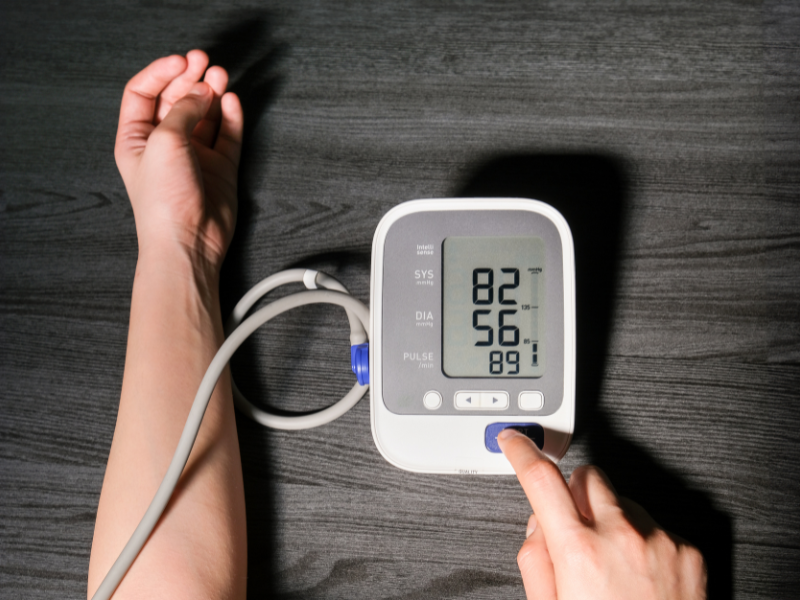When blood pushes against artery walls less forcefully than usual, Describe low blood pressure. The systolic (top) and diastolic (bottom) readings are used to monitor blood pressure. Generally, a normal value is 120/80 mmHg.
Low blood pressure is typically thought to be:
- reduced systolic pressure (<90 mmHg)
- Diastolic pressure below 60 millimetres Hg
The symptoms of low blood pressure are not always present in everyone. It’s actually common for some people. But when it manifests, it can disrupt day-to-day activities and necessitate medical care.some people. But when it manifests, it can disrupt day-to-day activities and necessitate medical care.
Typical Signs
The severity of the decline and the speed at which it occurs determine the symptoms of low blood pressure. Among the most typical symptoms are:
- Lightheadedness or dizziness
- Vision blur
- Weariness
- Feeling queasy
- Syncope, or fainting
- Clammy, cold skin
- Having trouble focussing
You should speak with a healthcare professional if you consistently encounter any of these symptoms since they could indicate low blood pressure.
Typical Signs

The severity of the decline and the speed at which it occurs determine the symptoms of Describe low blood pressure. Among the most typical symptoms are:
- Lightheadedness or dizziness
- Vision blur
- Weariness
- Feeling queasy
- Syncope, or fainting
- Clammy, cold skin
- Having trouble focussing
You should speak with a healthcare professional if you consistently encounter any of these symptoms since they could indicate low blood pressure.
In what way is identified?
Your physician may diagnose low blood pressure by:
- Take a blood pressure reading while standing, sitting, and lying downward.
- Go over your medical history and symptoms.
- Take blood testing.
- Encourage the use of an echocardiography or electrocardiogram (ECG)
- To observe how your body reacts to changes in position, do a tilt table test.
- Symptoms and regular readings below 90/60 mmHg will typically prove low blood pressure.
Why Do People Have Low Blood Pressure?
Low blood pressure can have a wide range of causes, including:
- A lack of fluids
Weakness and hypotension may result from your body losing more water than it is absorbing. - Issues with the Heart
Reduced arterial pressure may result from heart failure, bradycardia (lower pulse rate), or problems with the heart valves. - Hormonal Conditions
Low blood sugar and Addison’s disease are two conditions that can cause low blood pressure. - Blood Loss
Blood pressure might drop suddenly if there is severe internal bleeding or trauma-related bleeding. - Being pregnant
Because of hormonal changes and greater demands on blood flow, pregnant women frequently have low blood pressure. - Inadequate Nutrition
Low levels of folate and vitamin B12 can cause anaemia, which in turn can reduce blood pressure.
Alternatives for Treatment
Depending on its degree and cause, low blood pressure can be treated. Treatment might not be necessary if it is moderate and symptomless. But if there are symptoms, some potential therapies are as follows:
- Increasing Consumption of Salt
In contrast to those with high blood pressure, those with low blood pressure may benefit from eating extra salt if directed by a physician.
- Keeping Hydrated
Blood volume and blood pressure can both be increased by increasing fluid intake. - The Application of Compression Stockings
By doing this, blood circulation is enhanced and blood pooling in the legs is avoided. - Taking Care of the Root Causes
Resolving hormonal imbalances, altering medication, or treating cardiac problems can all aid in the management of low blood pressure.
Tips for Dietary Management of Low Blood Pressure
The proper diet can help maintain normal blood pressure levels. Among the food recommendations for those with low blood pressure are:
- (With doctor’s clearance) Increase the intake of foods high in salt.
- Water, herbal teas, and electrolyte drinks can help you stay hydrated.
- Quick, little meals to prevent blood pressure decreases after meals
- Eggs, leafy greens, and fortified cereals are examples of foods high in B12 and folate.
changes in Lifestyle for Low Blood Pressure
Making a few easy lifestyle changes is another aspect of managing low blood pressure:
- Get up carefully from a seated or sleeping position.
- Don’t stand for extended periods of time.
- To encourage circulation while sitting, cross your legs.
- Get regular, mild exercise.
- Steer clear of alcohol, as it might further reduce blood pressure.
- Due to the possibility of dehydration, use special caution in hot conditions.
By doing these actions, you can stabilise your blood pressure and keep your symptoms from getting in the way of your life.
When to Get Help from a Doctor
Although it’s not necessarily harmful, low blood pressure can be dangerous if:
- You lose consciousness or faint.
- You have trouble breathing or chest pain.
- Your symptoms make it difficult to go about your everyday life.
- Your blood pressure abruptly lowers.
If you suspect an underlying medical disease or your low blood pressure is accompanied by severe symptoms, get help right once.
Managing Low Blood Pressure Well
It’s important to identify the causes and collaborate with your healthcare medical professional to manage the condition. For a lot of people, minor adjustments to routine, food, and drinking can have a big effect. For others, medical care could be required.
The secret to controlling low blood pressure, in any case, is awareness. With the correct care, you can minimise symptoms and lead an active, healthy life.
In conclusion
Although low blood pressure might not seem as dangerous as hypertension, its effects on your health should not be undervalued. Understanding the signs, causes, and therapies of low blood pressure, whether it be chronic or sporadic, gives you the ability to take charge of your health.
Make educated lifestyle decisions, drink enough of water, and routinely check your Describe low blood pressure. You can properly control your low blood pressure and enhance your quality of life if you have a thorough grasp of the illness.

